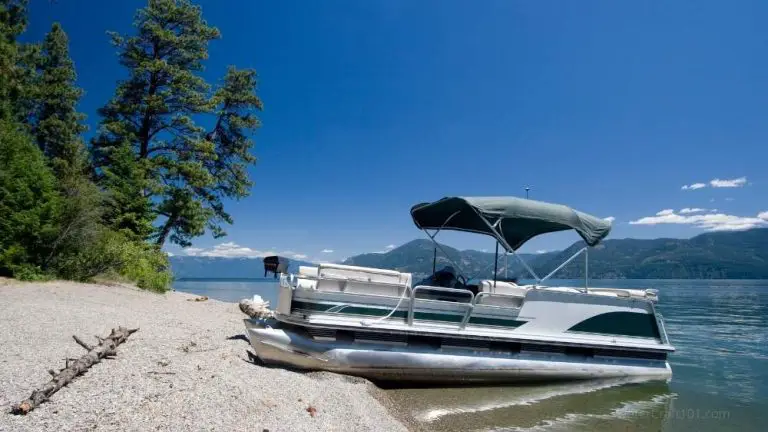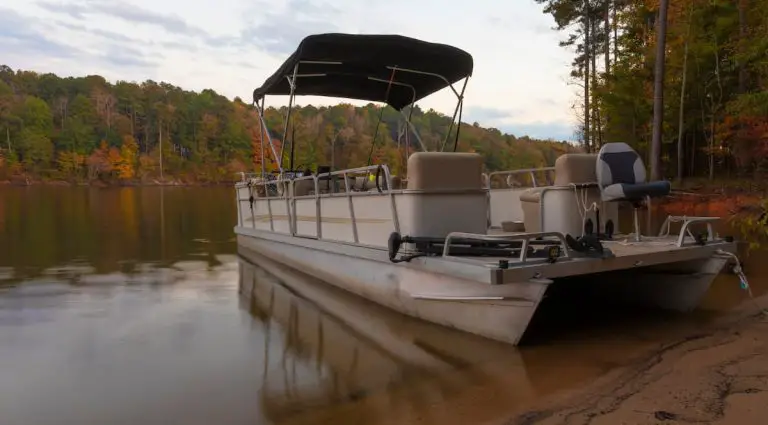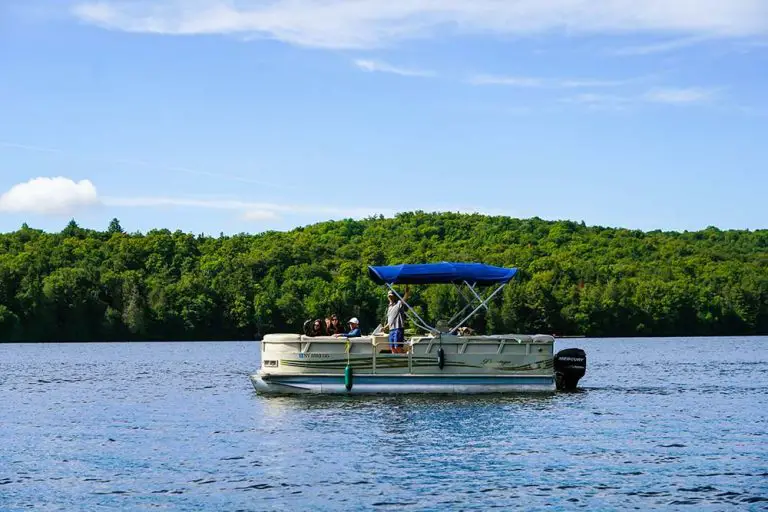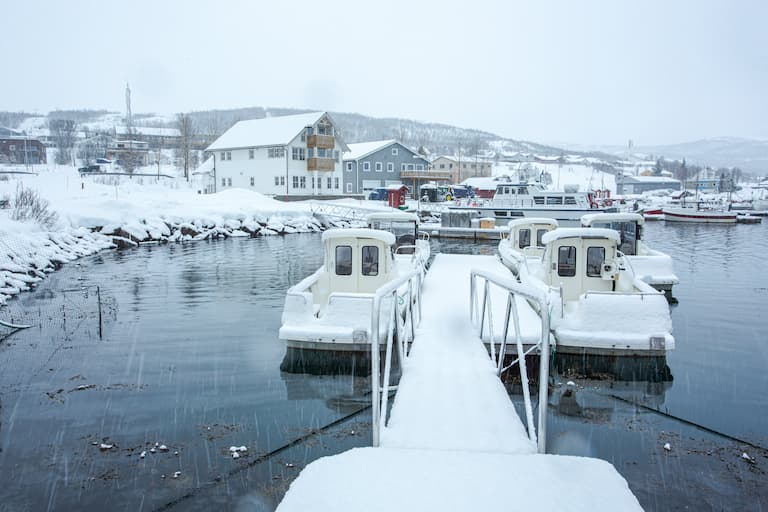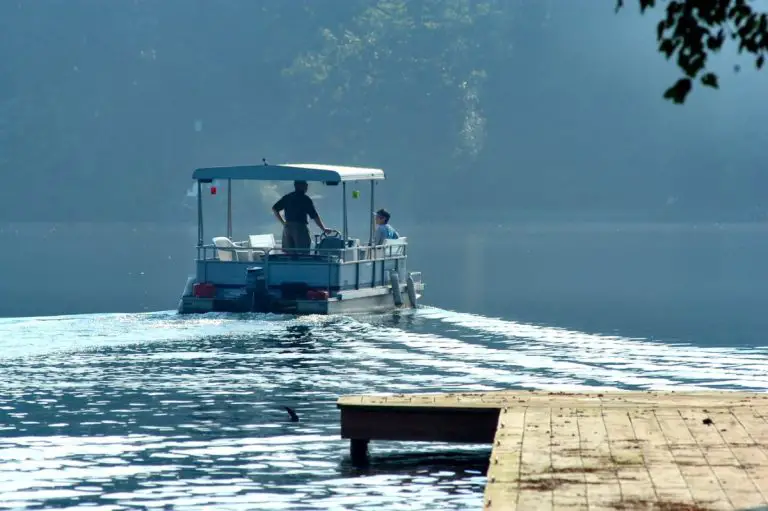How To Get Water Out of Your Pontoons? (Pontoon Boats)
When one pontoon is sitting suspiciously low in the water, you know it’s time for action. But what can you do to reduce the water in the pontoons of your boat?
Here’s how to get water out of your pontoons:
- Pull the pontoon boat to shore.
- Locate the leak.
- Lift the boat to tip out the water.
- Address the leak(s).
The rest of this article will discuss some steps you can take to remove the unwanted water from your boat’s pontoons and options for what to do with the leak!
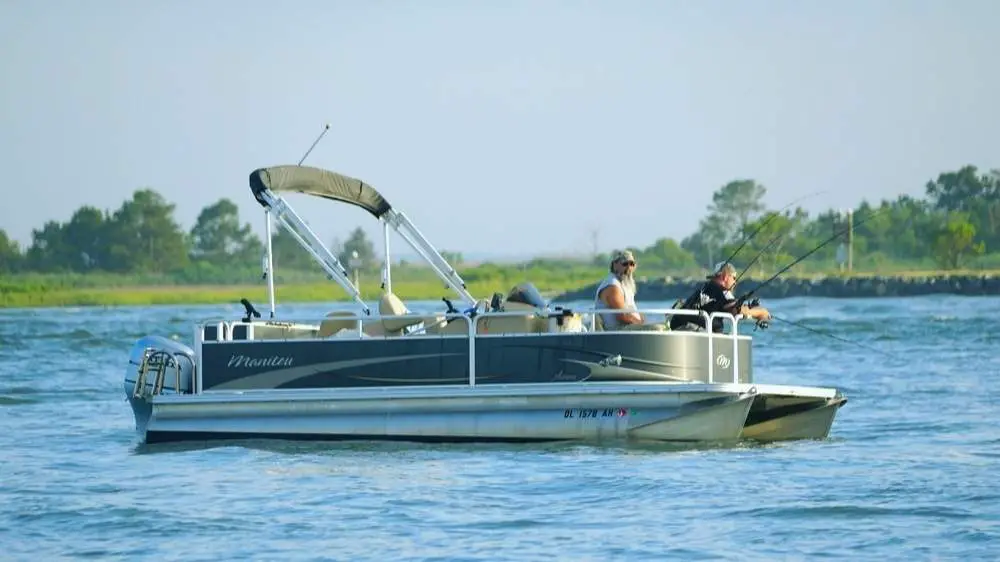
1. Pull the Pontoon Boat to Shore
It’s best to ground your boat for its water expulsion and a leak check-up. This way, you’ll be able to tilt the boat safely without fear of it becoming damaged further.
Below, I’ll go over a few helpful tips to consider when you pull your boat to shore:
Unload Loose Items To Reduce Weight
Pulling your boat ashore will not be a piece of cake if one or more of the pontoons is partially filled with water, but you can make it easier by unloading everything loose from your vessel beforehand. Once the pontoon is as light as possible, it will be easier to lift and tilt when the time comes.
Do not forget to remove loose seat cushions, pillows, and even your pontoon’s canopy (if it is removable).
Never Approach Shore Too Quickly
If you approach shallow water in your pontoon boat too quickly, you risk damaging the pontoons of your boat and the motor as you’re most likely riding lower in the water than normal. Make sure your engine is on low as the water recedes.
Shut off and stow the motor altogether when the water depth is between 4 and 6 feet (1.21 and 1.82 meter), just to be safe. From there, use a paddle or a pole to push your pontoon ashore.
Have People Helping From Land
Having people on land to help you with your pontoon beaching is essential. They will help you correctly gauge the distance between your boat and the shore, and they can help you with the task of pulling or pushing the boat onto the sand or grass when you are close enough.
Of course, getting the boat onto its trailer is even better but may not be an option if you’re taking on water and you’re far away from where you launched it.
Trying to do everything yourself can lead to accidentally damaging your boat.
2. Locate the Leak in The Pontoon
Even if your boat has drain plugs for getting rid of the unwanted water, you’ll still have to deal with the source of the water entry at some point. Finding the pesky leak is significant because, depending on the size, you may be able to patch it yourself.
It might be easiest to find the leak with water still in the pontoons (since it will drip out the same way it got in). It’s best to inspect your pontoon boat as soon as you have it in a good position.
Be sure to pay close attention to seams and pontoon parts that may have scraped against hard surfaces recently (the bottom of the pontoons and the sides nearest the dock). It’s best to have three or more people helping with this stage.
Once you spot a leak, mark it with tape,chalk, or some other substance so you don’t lose it. Even though you may feel like giving up now, keep going and search the entire pontoon to make sure there is only one leak.
This thoroughness will serve you best in the end, as it’s better to have all holes dealt with at once than to have to go through the whole process of leak-finding again because you weren’t diligent enough the first time.
3. Lift the Pontoon Boat to Tip Out the Water
Most pontoon boats have drain plugs. If your model has drain plugs in the pontoons, emptying the water from them is pretty straightforward. Unplug the provided holes, and then tip the boat towards the holes until the water is gone.
However, if your boat doesn’t have drain plugs, you’ll need to let the water seep out of the pontoon through the leak or leaks by which it came in. Tip the boat towards the leaks and be prepared to prop the boat up for a time. If the leaks are small, draining the water will take a long while.
If you are able to get the boat back on its trailer, this will be the easiest way to drain the water. By parking on a slope or adjusting the height of the trailer at the tongue you should be able to get the water inside the pontoons over to either the drain plug or the spot where the leak was found.

4. Address the Pontoons Leak(s)
Now that the pontoons are empty of water, you can deal with the root of the problem: the leak. Thankfully, you have a few options moving forward! I’ll go over these options below.
Patch the Leak Yourself
If the leak is small enough, there is a chance you can fix it yourself. Here is a step-by-step guide to sealing a leak by It Still Runs, a website that answers questions about vehicle maintenance.
Before taking this advice, you will want to make sure that your boat’s pontoons are aluminum. Most pontoons are, but it’s good to check before trying to apply aluminum putty to the vessel.
Check Your Pontoon Boat’s Warranty
Checking if the leak is covered under your boat’s warranty is always worth a shot if your pontoon is relatively new. If you didn’t keep the physical copy of the contract, it’s always possible to look up the warranty online by searching your boat’s manufacturer.
Even limited warranties will often include pontoons as part of the “main boat.”
Bring Your Pontoon Boat Into the Shop
If the leak is too big to mend yourself (or your pontoons are not made with aluminum), you’ll want to call and schedule a time to bring your boat into a repair shop. Make sure you check your boater’s insurance and get your pontoon to a shop that accepts it.
If you have your boat insured in a state other than the one you live in, consider this as well.
Final Thoughts
A leaky boat is never fun to deal with, but most pontoon leaks are not too serious. Pontoons are hardy vessels made to survive a few bumps and bruises, and a few repairs should make your boat seaworthy again!
Hopefully, this guide has helped you determine how to get water out of your pontoons so your vessel will be sea or lake worthy without delay.
The best way to prevent leaks in the future is to be careful of shallow water, sandbars, other boats, and rocky shores. You’ll never be able to keep your pontoon completely safe, but making sure you don’t run aground at high speeds is a good start.

